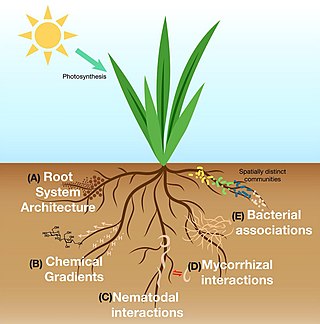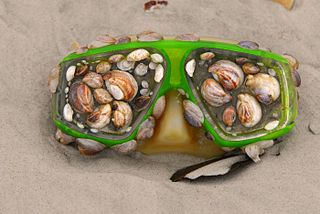Related Research Articles

A microorganism, or microbe, is an organism of microscopic size, which may exist in its single-celled form or as a colony of cells.

Geomicrobiology is the scientific field at the intersection of geology and microbiology and is a major subfield of geobiology. It concerns the role of microbes on geological and geochemical processes and effects of minerals and metals to microbial growth, activity and survival. Such interactions occur in the geosphere, the atmosphere and the hydrosphere. Geomicrobiology studies microorganisms that are driving the Earth's biogeochemical cycles, mediating mineral precipitation and dissolution, and sorbing and concentrating metals. The applications include for example bioremediation, mining, climate change mitigation and public drinking water supplies.

Microbial ecology is the ecology of microorganisms: their relationship with one another and with their environment. It concerns the three major domains of life—Eukaryota, Archaea, and Bacteria—as well as viruses.

The rhizosphere is the narrow region of soil or substrate that is directly influenced by root secretions and associated soil microorganisms known as the root microbiome. Soil pores in the rhizosphere can contain many bacteria and other microorganisms that feed on sloughed-off plant cells, termed rhizodeposition, and the proteins and sugars released by roots, termed root exudates. This symbiosis leads to more complex interactions, influencing plant growth and competition for resources. Much of the nutrient cycling and disease suppression by antibiotics required by plants, occurs immediately adjacent to roots due to root exudates and metabolic products of symbiotic and pathogenic communities of microorganisms. The rhizosphere also provides space to produce allelochemicals to control neighbours and relatives.
The International Society for Microbial Ecology (ISME) is the principal scientific society for the burgeoning field of microbial ecology and its related disciplines. ISME is a non-profit association and is owner of the International Symposia on Microbial Ecology and also owner of The ISME Journal which is published by Springer Nature. The ISME Office is based at the Netherlands Institute of Ecology in Wageningen, The Netherlands.

Oral ecology is the microbial ecology of the microorganisms found in mouths. Oral ecology, like all forms of ecology, involves the study of the living things found in oral cavities as well as their interactions with each other and with their environment. Oral ecology is frequently investigated from the perspective of oral disease prevention, often focusing on conditions such as dental caries, candidiasis ("thrush"), gingivitis, periodontal disease, and others. However, many of the interactions between the microbiota and oral environment protect from disease and support a healthy oral cavity. Interactions between microbes and their environment can result in the stabilization or destabilization of the oral microbiome, with destabilization believed to result in disease states. Destabilization of the microbiome can be influenced by several factors, including diet changes, drugs or immune system disorders.

Microbiology is the scientific study of microorganisms, those being of unicellular (single-celled), multicellular, or acellular. Microbiology encompasses numerous sub-disciplines including virology, bacteriology, protistology, mycology, immunology, and parasitology.
Roberto Kolter is Professor of Microbiology, Emeritus at Harvard Medical School, an author, and past president of the American Society for Microbiology. Kolter has been a professor at Harvard Medical School since 1983 and was Co-director of Harvard's Microbial Sciences Initiative from 2003-2018. During the 35-year term of the Kolter laboratory from 1983 to 2018, more than 130 graduate student and postdoctoral trainees explored an eclectic mix of topics gravitating around the study of microbes. Kolter is a fellow of the American Association for the Advancement of Science and of the American Academy of Microbiology.
A microbial consortium or microbial community, is two or more bacterial or microbial groups living symbiotically. Consortiums can be endosymbiotic or ectosymbiotic, or occasionally may be both. The protist Mixotricha paradoxa, itself an endosymbiont of the Mastotermes darwiniensis termite, is always found as a consortium of at least one endosymbiotic coccus, multiple ectosymbiotic species of flagellate or ciliate bacteria, and at least one species of helical Treponema bacteria that forms the basis of Mixotricha protists' locomotion.
Microbial food cultures are live bacteria, yeasts or moulds used in food production. Microbial food cultures carry out the fermentation process in foodstuffs. Used by humans since the Neolithic period fermentation helps to preserve perishable foods and to improve their nutritional and organoleptic qualities. As of 1995, fermented food represented between one quarter and one third of food consumed in Central Europe. More than 260 different species of microbial food culture are identified and described for their beneficial use in fermented food products globally, showing the importance of their use.

The plastisphere consists of ecosystems that have evolved to live in human-made plastic environments. All plastic accumulated in marine ecosystems serves as a habitat for various types of microorganisms, with the most notable contaminant being microplastics. There are an estimate of about 51 trillion microplastics floating in the oceans. Relating to the plastisphere, over 1,000 different species of microbes are able to inhabit just one of these 5mm pieces of plastic.

The root microbiome is the dynamic community of microorganisms associated with plant roots. Because they are rich in a variety of carbon compounds, plant roots provide unique environments for a diverse assemblage of soil microorganisms, including bacteria, fungi and archaea. The microbial communities inside the root and in the rhizosphere are distinct from each other, and from the microbial communities of bulk soil, although there is some overlap in species composition.

A microbiome is the community of microorganisms that can usually be found living together in any given habitat. It was defined more precisely in 1988 by Whipps et al. as "a characteristic microbial community occupying a reasonably well-defined habitat which has distinct physio-chemical properties. The term thus not only refers to the microorganisms involved but also encompasses their theatre of activity". In 2020, an international panel of experts published the outcome of their discussions on the definition of the microbiome. They proposed a definition of the microbiome based on a revival of the "compact, clear, and comprehensive description of the term" as originally provided by Whipps et al., but supplemented with two explanatory paragraphs. The first explanatory paragraph pronounces the dynamic character of the microbiome, and the second explanatory paragraph clearly separates the term microbiota from the term microbiome.
Microbiomes of the built environment is a field of inquiry into the communities of microorganisms that live in human constructed environments like houses, cars and water pipes. It is also sometimes referred to as microbiology of the built environment.
Victoria J. Orphan is a geobiologist at the California Institute of Technology who studies the interactions between marine microorganisms and their environment. As of 2020, she is the Chair for the Center of Environmental Microbial Interactions.
Emily P. Balskus is an American chemical biologist, enzymologist, microbiologist, and biochemist born in Cincinnati, Ohio in 1980. She has been on the faculty of the Chemistry and Chemical Biology department of Harvard University since 2011 and is currently the Morris Kahn Professor. She has published more than 80 peer-reviewed papers and three book chapters. Since 2012 she has been invited to give over 170 lectures, has held positions on various editorial boards, and served as a reviewer for ACS and Nature journals among others. Balskus also currently serves as a consultant for Novartis, Kintai Therapeutics, and Merck & Co.

The plant microbiome, also known as the phytomicrobiome, plays roles in plant health and productivity and has received significant attention in recent years. The microbiome has been defined as "a characteristic microbial community occupying a reasonably well-defined habitat which has distinct physio-chemical properties. The term thus not only refers to the microorganisms involved but also encompasses their theatre of activity".

Since the colonization of land by ancestral plant lineages 450 million years ago, plants and their associated microbes have been interacting with each other, forming an assemblage of species that is often referred to as a holobiont. Selective pressure acting on holobiont components has likely shaped plant-associated microbial communities and selected for host-adapted microorganisms that impact plant fitness. However, the high microbial densities detected on plant tissues, together with the fast generation time of microbes and their more ancient origin compared to their host, suggest that microbe-microbe interactions are also important selective forces sculpting complex microbial assemblages in the phyllosphere, rhizosphere, and plant endosphere compartments.
Catalina Cuellar-Gempeler is a Colombian microbial ecologist and marine microbiologist, currently teaching and doing research at Cal Poly Humboldt. Her research focuses mainly on understanding microbial meta-community, eco-evolutionary dynamics, and ecosystem dynamics. The Catalina Cuellar-Gempeler lab is currently focused on studying the interactions between hosts and their microbial communities. The lab's main emphasis is on the microbes used in digestion in the Californian and Eastern carnivorous pitcher plants. In March 2021, Cuellar-Gempeler was awarded an Early Career grant of $1 million by the National Science Foundation.

Jamie S. Foster is an American astrobiologist, microbiologist, and academic. She is a professor at the Department of Microbiology and Cell Science, and Genetics and Genomes Graduate Program at the University of Florida.
References
- 1 2 Smith, Peter Andrey (2012-05-16). "Momofuku Puts Mold, Bacteria on the Menu". Wired. ISSN 1059-1028 . Retrieved 2019-03-10.
- 1 2 Smith, Peter. "Fish Sauce, Ketchup and the Rewilding of Our Food". Smithsonian. Retrieved 2019-03-10.
- 1 2 3 Smith, Peter Andrey (2012-09-17). "For Gastronomists, a Go-To Microbiologist". The New York Times. ISSN 0362-4331 . Retrieved 2019-03-10.
- 1 2 "Molecular biologist talks cheese". phys.org. Retrieved 2019-03-10.
- ↑ Button, Julie E.; Dutton, Rachel J. (2012-08-07). "Cheese microbes". Current Biology. 22 (15): R587–589. doi: 10.1016/j.cub.2012.06.014 . ISSN 1879-0445. PMID 22877773.
- ↑ Wolfe, Benjamin E.; Dutton, Rachel J. (2013). "Towards an Ecosystem Approach to Cheese Microbiology". Microbiology Spectrum. 1 (1). doi:10.1128/microbiolspec.CM-0012-12. ISSN 2165-0497. PMID 26184819.
- 1 2 Zimberoff, Larissa (2017-02-06). "Small Cheese Makers Invest in a Stinky Science". The New York Times. ISSN 0362-4331 . Retrieved 2019-03-10.
- 1 2 Wolfe, Benjamin E.; Button, Julie E.; Santarelli, Marcela; Dutton, Rachel J. (2014-07-17). "Cheese rind communities provide tractable systems for in situ and in vitro studies of microbial diversity". Cell. 158 (2): 422–433. doi:10.1016/j.cell.2014.05.041. ISSN 1097-4172. PMC 4222527 . PMID 25036636.
- ↑ Miller, Greg (2014-07-31). "Scientists Uncover a Surprising World of Microbes in Cheese Rind". Wired. ISSN 1059-1028 . Retrieved 2019-03-10.
- ↑ "Cheese-based research". Harvard Gazette. 2014-07-28. Retrieved 2019-03-10.
- ↑ Morin, Manon; Pierce, Emily C.; Dutton, Rachel J. (2018). "Changes in the genetic requirements for microbial interactions with increasing community complexity". eLife. 7. doi: 10.7554/eLife.37072 . ISSN 2050-084X. PMC 6175579 . PMID 30211673.
- ↑ "Competition and Cooperation of Cheese Rind Microbes Exposed". The Scientist Magazine®. Retrieved 2019-03-10.
- ↑ Bonham, Kevin S.; Wolfe, Benjamin E.; Dutton, Rachel J. (2017). "Extensive horizontal gene transfer in cheese-associated bacteria". eLife. 6. doi: 10.7554/eLife.22144 . ISSN 2050-084X. PMC 5526665 . PMID 28644126.
- ↑ Cooked , retrieved 2019-03-10
- ↑ "Cooked (2015) s01e04 Episode Script | SS". Springfield! Springfield!. Retrieved 2019-03-10.
- ↑ "Rachel Dutton". Science & Food. 2013-08-20. Retrieved 2019-10-08.
- ↑ "Welcome to the Dutton Lab". The Dutton Lab @ UCSD. Retrieved 2019-10-08.
- ↑ "A Wedge of Science: A Spotlight on Cheese". Science Friday. Retrieved 2019-03-10.
- ↑ "The Cheese Microbiome with Rachel Dutton". ASM.org. Retrieved 2019-10-08.
- ↑ Buschman, Heather; McDonald, Kim; Ph.D. ’08 (2016-11-01). "Say Cheese". Triton. Retrieved 2019-03-10.
{{cite web}}: CS1 maint: numeric names: authors list (link) - ↑ "FAS Center: Rachel Dutton". archive.sysbio.harvard.edu. Retrieved 2019-10-08.
- ↑ "Dutton, Rachel". The David and Lucile Packard Foundation. Retrieved 2019-03-10.
- ↑ "UC San Diego Biologists Named Pew Scholars". ucsdnews.ucsd.edu. Retrieved 2019-03-10.
- ↑ "New Innovator Award Recipients". commonfund.nih.gov. 26 June 2013. Retrieved 2019-03-10.